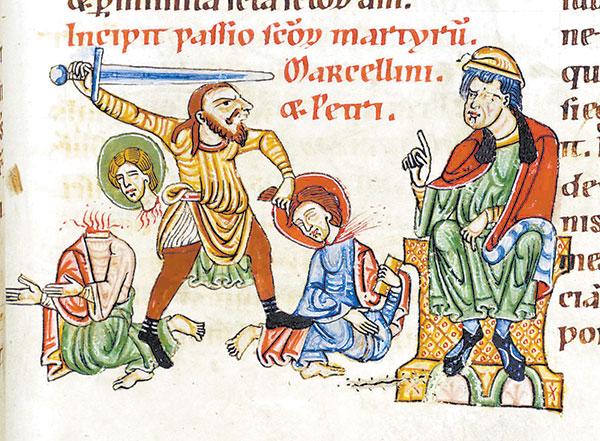 On June 2, the Catholic Church remembers two fourth-century martyrs, Sts. Marcellinus and Peter, who were highly venerated after the discovery of their tomb and the conversion of their executioner.
On June 2, the Catholic Church remembers two fourth-century martyrs, Sts. Marcellinus and Peter, who were highly venerated after the discovery of their tomb and the conversion of their executioner.
Although the biographical details of these two martyrs are largely unknown, it is known that they lived and died during the reign of the Roman Emperor Diocletian. In 302, the ruler changed his tolerant stance towards Christians and pursued a brutal policy intended to eliminate the Church from the empire.
Diocletian and his subordinate ordered the burning of Catholic churches and their sacred texts, as well as the imprisonment and torture of clergy and laypersons. His goal was to force Christians to submit to the Roman pagan religion, including the worship of the emperor himself as divine.
It was at the mid-point of this persecution, around 303, that a Roman exorcist by the name of Peter was imprisoned for his faith. While in prison, tradition holds that Peter freed Paulina, the daughter of the prison-keeper Artemius, from demonic influence by his prayers.
This demonstration of Christ's power over demons is said to have brought about the conversion of Paulina, Artemius, his wife and the entire household – all of whom were baptized by the Roman priest Marcellinus.
After this, both Marcellinus and Peter were called before a judge who was determined to enforce the emperor's decree against the Church. When Marcellinus testified courageously to his faith in Christ, he was beaten, stripped of his clothes and deprived of food in a dark cell filled with broken glass shards.
Peter, too, was returned to his confinement. But neither man would deny Christ, and both preferred death over submission to the cult of pagan worship..
It was arranged for the two men to be executed secretly, to prevent the faithful from gathering in prayer and veneration at the place of their burial. Their executioner forced them to clear away a tangle of thorns and briars, which the two men did cheerfully, accepting their death with joy.
Both men were beheaded in the forest and buried in the clearing they had made. The location of the saints' bodies remained unknown for some time, until a devout woman named Lucilla received a revelation informing her where the priest and exorcist lay.
With the assistance of another woman, Firmina, Lucilla recovered the two saints' bodies and had them re-interred in the Roman Catacombs. Sts. Marcellinus and Peter are among the saints named in the Western Church's most traditional Eucharistic prayer, the Roman Canon.
Pope St. Damasus I, who was himself a great devotee of the Church's saints during his life, composed an epitaph to mark the tombs of the two martyrs. The source of his knowledge, he said, was the executioner himself, who had subsequently repented and joined the Catholic Church.
— Benjamin Mann, Catholic News Agency
St. Charles and many other martyrs for the faith died between Nov. 15, 1885, and Jan. 27, 1887, in Namugongo, Uganda. St. Charles and his companions were beatified in 1920 and canonized by Pope Paul VI in 1964.
In 1879 Catholicism began spreading in Uganda when The Society of Missionaries of Africa (the "White Fathers"), a congregation of priests founded by Cardinal Lavigerie were peacefully received by King Mutesa of Uganda.
The priests soon began preparing catechumens for baptism and before long a number of the young pages in the king's court had become Catholics.
However, on the death of Mutesa, his son Mwanga, a corrupt man who ritually engaged in pedophilic practices with the younger pages, took the throne.
When King Mwanga had a visiting Anglican bishop murdered, his chief page, Joseph Mukasa, a Catholic who went to great length to protect the younger boys from the king's lust, denounced the king's actions and was beheaded on Nov. 15, 1885.
The 25-year-old Charles Lwanga became the chief page, and just as forcibly protected them from the king's advances.
On the night of the martyrdom of Joseph Mukasa, Lwanga and some of the other pages went to the White Fathers to receive baptism.
In May 1886, King Mwanga learned that one of the boys was learning catechism. He was furious and ordered all the pages to be questioned to separate the Christians from the others. With great courage, Charles led 24 young pages, aged 13 to 25, to proclaim their Christian faith.
They were condemned to march 37 miles to their place of execution, Namugongo, where they were to be burned at the stake. On the way, Matthias Kalemba, was cut to pieces by the executioners and left to die.
On June 3, 1886, the Feast of the Ascension, Charles Lwanga was separated from the others and burned at the stake. The executioners slowly burnt his feet until there was only charred remains, but he was still alive. Then they promised they would let him go if he renounced his faith. He refused, saying, "You are burning me, but it is as if you are pouring water over my body." Just before the flames reached his heart, he looked up and said in a loud voice, "Katonda! – My God!" and died. He was only 21 years old.
There were 22 protomartyrs in all. The persecutions spread during the reign of Mwanga, with 100 Christians, both Catholics and Protestants, being tortured and killed.
— Catholic News Agency

